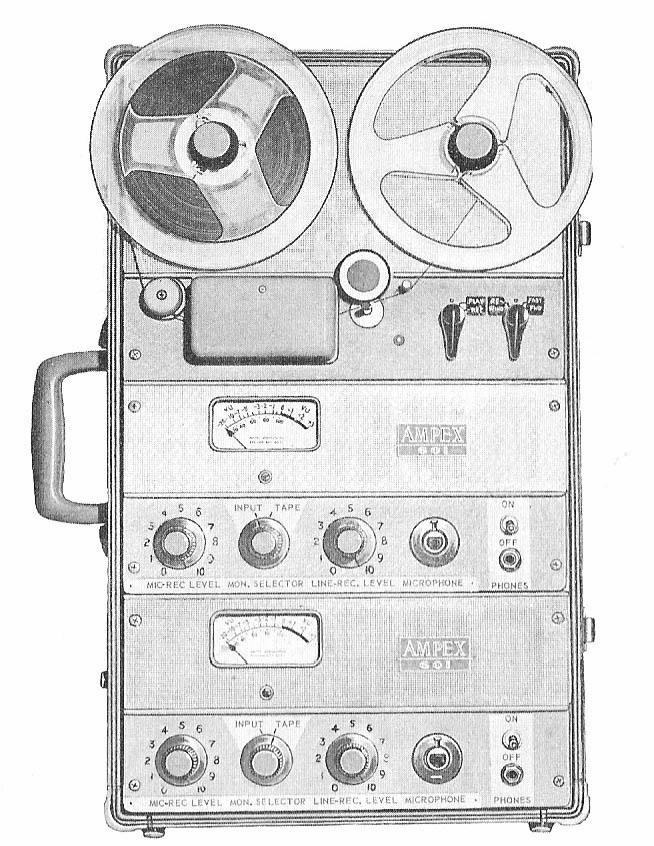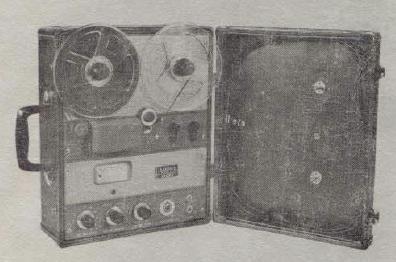It is capable of recording and playing back two signals simultaneously, one on each half of the tape width. Recording and playback can be carried out independently on the two channels. There are two inputs to this recorder, one to each channel. They will accept either a signal from a microphone or a line signal from a radio receiver. Operating speed was determined at time of purchase since the machine can only run at one speed - either 3.75 or 7.5 inches per second. The RCN purchased the dual channel version of this machine although it could be ordered as a single channel model. The tape speed for RCN useage is not known at this time.
Because the unit was capable of recording two independent channels, in SUPRAD applications it was used to determine whether signals on two separate frequencies were truly simultaneous. Frequency One would be recorded on track A, and Frequency Two would be recorded on track B. Thus, the "Recording" function of these tracks was capable of recording either simultaneous transmissions or, say, two ends of a communications link, such as a Morse code station on one frequency and the responding Morse station on another. It was used for Morse code, other telegraphic systems, and voice channels.
At only 26 pounds, this unit was the lightest of portable tape recorders
when first introduced.
 |
|
|
SPECIFIC APPLICATIONS
One reported assignment for this tape recorder was on an RCN trip to the Eastern Baltic in 1965. "The 601, was really a superb machine because of its low signal to noise ratio and wide frequency response. We used it on our multi-ship trip to the eastern Baltic in 1965 primarily to record the Soviet Chayka (their version of Loran-C) system that was being introduced at the time. We would put the Chayka on track 1, and on track 2 we would record the timing output of our Rhode and Schwartz frequency standard. Thus, it could be played back later for analysis".
Spud Roscoe recalls an uncanny use of the Ampex 601 in Coverdale. "One day, one of the guys on duty made an endless tape of Sheb Wooley's song Purple People Eater and we listened to it steady for an 8-hour shift. It was truly amazing we didn't go out of our minds listening to this song ". The Purple People Eater was the #1 song for 6 weeks in 1958 and the #24 song of the 1955-1959 rock era. It sold over 3 million records and received a Gold Record within 3 weeks after it was released. Overall, it sold 100 million copies.
SPECIFICATIONS
Tape speeds: 7.5 ips or 3.75 ips (but not both)
Frequency response: 40 to 15,000 Hz
Signal/Noise ratio: 55 dB
Wow and flutter: less than 0.17%
Inputs: High impedance microphone input and line input
Tube compliment: 3 x 12AU7, 1 x 12AY7, 2 x 5879, 1 x 6F5 and 1 x 5Y3
Outputs: 600 ohm balanced or unbalanced line.
Reel size: 7"
Heads: Separate record, playback and erase
Weight: 26 pounds
Size: 8" deep x 14" wide x 16.5" high
Circa: Made between 1956 - 1960
Colour: The 601 has been observed in both tan/light-brown an gray livery
from photos on the web.
Price: In 1960 it was around $US 995 for the two-track unit and
$US 600 for the single track model.
This recorder, highly prized by collectors and audiophiles for its superior tube electronics, is still in demand as of 2007.
 |
| This image shows the lid. (Courtesy Ampex Manuals web site) |